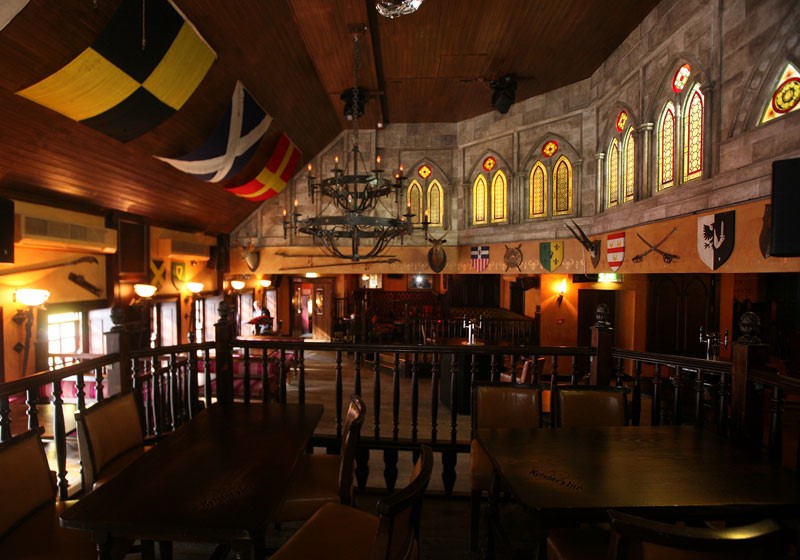A wee ditty on County Kilkenny Ireland, home of the brave.
Why am I writing about Kilkenny you ask? I have a huge family over there, mum came from there and I have been many times, lived there from the age of 3 to 6 years old, aye, I am half Irish, the smaller half by the way. A historic (or is it hysteric) view of a couple of places … photo shows Kyteler’s Inn, courtesy of the pub itself.
Burnchurch Castle, is a well-preserved 15th century Norman tower house with a round gate tower in County Kilkenny, Ireland, said to have been built/owned by the Fitzgeralds in 15th century and continued to be occupied until 1817. It is 4 miles south west of Kilkenny City, off the Clonmel Road, close to Kells Priory. A high circular turret still remains. A great hall was attached to the tower’s outside wall, but this has now gone. A curved outside staircase provides access to three upper floors of the tower – it can be explored carefully. It has mullioned windows and fine carved fireplace, it’s similar to Clara Castle in Clara. It‘s known for being one of several Irish towers with the narrower sides of the castle extending up an additional floor, creating a pair of tower wide turrets. Clara Castle or peel tower is also in County Kilkenny, is about 4 miles east of Kilkenny City. Clara was built late 15th/early 16th century by the Shortall family (now there’s a name, typically Irish slant), who lived there until 1640’s. The castle was occupied up until 1905. Clara is five storeys tall has and many of its original oak doors and floor beams. There is a murder-hole above the entrance, which is also protected by a yett and drawbar. The third floor has a secret chamber and the top floor chamber is the largest and best-lit room in the castle, used for general family living.
Kells (Irish: Ceanannas) is a village in County Kilkenny about 10 miles south of Kilkenny itself. It is on high ground to the south of the Kings River. By the way history fact lovers – Kilree round tower and 9th century high cross, is said to be the burial place of Niall Caille, just south of Kells. The famous racehorse Red Rum was bred at Rossenarra stud in Kells. Back to Kells, where we had a family farm years back, the Augustine priory of Kells is alongside King’s River beside the village of Kells, about 10 miles south of medieval Kilkenny. One of its most striking features is a collection of medieval tower houses at intervals along and within walls – a site of just over 3 acres. These give the priory the appearance more of a fortress than of a place of worship and its local name is ‘Seven Castles of Kells’. It was founded by Geoffrey FitzRobert in 1193. FitzRobert was brother-in-law to Strongbow and the priory came after an earlier church dedicated to St Mary, the Blessed Virgin and served as parish church to Kells. In 1324 the Bishop of Ossory Richard de Ledrede paid a visit to the priory. Following an inquisition into a Kilkenny sect of heretics, Alice Kyteler and William Outlawe (grand names) were ordered to appear before the Bishop to answer charges of witchcraft. Outlaw was supported by Arnold de Paor, Lord of Kells who arrested the Bishop and had him imprisoned in Kilkenny Castle for 17 days. Kyteler fled to England and remained there. Dissolution of Kells Priory finally took place in March 1540 and the church and property were surrendered to James Butler, 9th Earl of Ormonde. Those French names are everywhere, pubs, castles and hotels etc. The existing ruin dates from the 14th/15th centuries. It consists of a church, chapel, prior’s residence or sacristy and a number of domestic buildings, all standing on an enclosed site of 4 acres.
Then there is Kilkenny City, one of the best places in the world, my mother’s family all originated from Co Kilkenny, Kells in fact. Irishtown, Kilkenny Irishtown (Irish: An Baile Gaelach) is the neighbourhood in Kilkenny around St Canice’s Cathedral, separated by the River Breagagh from the walled town of Kilkenny. When the Diocese of Ossory was established at the Synod of Ráth Breasail in 1111, its original cathedral was at the Abbey of Aghaboe. However, it was moved in the 1120s to Kilkenny, the capital of the Mac Giolla Phádraig dynasty of the Kingdom of Ossory. After the Norman invasion of Ireland, the Anglo-Normans built Kilkenny Castle nearby as the seat of the new County of Kilkenny. Kilkenny and Irishtown were both walled towns with separate walls, connected by Watergate Bridge over the Breagagh. Irishtown was poorer than Kilkenny, the Normans pushed all the locals away out of town and where they settled was the Irish people’s place. In 1609, Kilkenny borough was made a city and a County of the City was created, separate from County Kilkenny, with its own sheriff and grand jury. The city comprised parts of four parishes, and the new county covered the whole of each, with the area outside the borough forming the “liberties” of the city. The borough of Irishtown in the parish of St Canice was in the liberties of the County of the City of Kilkenny. It was through Dean’s Gate in 1650 that Cromwell’s army entered Irishtown and from there captured Kilkenny, capital of Confederate Ireland. That’s another story – when I have cooled off, grrrr – Cromwell.
Killamery High Cross Irish: Ardchros Chill Lamraí – is 12 foot high, 9th century AD stands in the graveyard at the monastic site of Killamery some 10 miles north of Kilkenny. A monastery was established by St Goban, a disciple of St Fursey, in 632. There is also a cross-base, two holed stones (bullauns) and a holy well. Killamery is also spelt as Cill Lamrai. It is sculptured on the shaft of the E face with three marigold flowers. There is a boss in the middle of the wheel-head that is surrounded by serpents and, above the boss an open-mouthed dragon. Noah in his ark is depicted on the arm and scenes from the life of St John the Baptist. On the base an inscription recalls: OR DO MAELSECHNAILL or ‘a prayer for Maelsechnaill’, who was high king of Ireland 846-862. Locals touched the cross’s capstone to cure headaches, it didnee do it for me, too much good Irish whiskey the night before.

